Deck 14: Implementing Cisco Service Provider Advanced Routing Solutions (SPRI)
Question
Question
Question
Question
Question
Question
Question
Question
Question
Question
Question
Question
Question
Question
Question
Question
Question
Question
Question
Question
Question
Question
Question
Question
Question
Question
Question
Question
Question
Question
Question
Question
Question
Question
Question
Question
Question
Question
Question
Question
Question
Question
Question
Question
Question
Question
Question
Question
Question
Question
Question
Question
Question
Question
Question
Question
Question
Question
Question
Question
Question
Question
Question
Question
Question
Question
Question
Question
Question
Question
Question
Question
Question
Question

Unlock Deck
Sign up to unlock the cards in this deck!
Unlock Deck
Unlock Deck
1/74
Play
Full screen (f)
Deck 14: Implementing Cisco Service Provider Advanced Routing Solutions (SPRI)
1
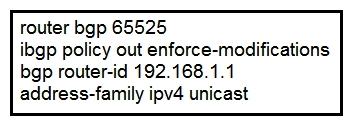 Refer to the exhibit. Router 1 is a core ABR in a Cisco Unified MPLS environment. All of the router 1 BGP peers are established, but traffic between customers is failing. Which BGP configuration must be added to the configuration?
Refer to the exhibit. Router 1 is a core ABR in a Cisco Unified MPLS environment. All of the router 1 BGP peers are established, but traffic between customers is failing. Which BGP configuration must be added to the configuration?A) It must be configured for graceful restart
B) It must be configured with a route reflector
C) It must be configured with send labels
D) It must be configured with PIC edge
It must be configured with send labels
2
Which statement about enabling segment routing for IGPs is true?
A) Segment routing must first be enabled under then routing process and then globally
B) Segment routing must first be enabled globally and then under the routing process
C) Segment routing can be enabled only under the routing process
D) Segment routing can be enabled only globally
A) Segment routing must first be enabled under then routing process and then globally
B) Segment routing must first be enabled globally and then under the routing process
C) Segment routing can be enabled only under the routing process
D) Segment routing can be enabled only globally
Segment routing must first be enabled globally and then under the routing process
3
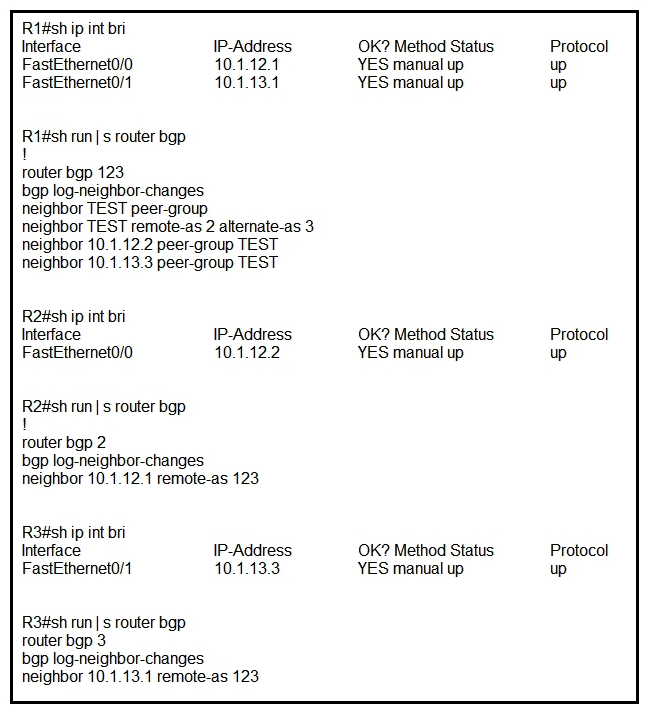 Refer to the exhibit. R1 is directly connected to R2 and R3. R1 is in BGP AS 123, R2 is in BGP AS 2, and R3 is in BGP AS 3. Assume that there is no connectivity issue between R1, R2 and R1, R3. Which result between BGP peers R1, R2 and R1, R3 is true?
Refer to the exhibit. R1 is directly connected to R2 and R3. R1 is in BGP AS 123, R2 is in BGP AS 2, and R3 is in BGP AS 3. Assume that there is no connectivity issue between R1, R2 and R1, R3. Which result between BGP peers R1, R2 and R1, R3 is true?A) The BGP session does not come up between R1 and R2 and between R1 and R3.
B) The BGP session comes up between R1 and R2 and between R1 and R3.
C) The BGP session comes up between R1 and R3, but not between R1 and R2.
D) The BGP session comes up between R1 and R2, but not between R1 and R3.
The BGP session comes up between R1 and R2 and between R1 and R3.
4
For which reason can two devices fail to establish an OSPF neighbor relationship?
A) The two devices have different process IDs
B) The two devices have different network types
C) The two devices have different router IDs
D) The two devices have the same area ID
A) The two devices have different process IDs
B) The two devices have different network types
C) The two devices have different router IDs
D) The two devices have the same area ID

Unlock Deck
Unlock for access to all 74 flashcards in this deck.
Unlock Deck
k this deck
5
Which two statements about mapping multicast IP addresses to MAC addresses are true? (Choose two.)
A) All mapped multicast MAC addresses begin with 0x0100.5E
B) The router performs the mapping before it hands the packet off to a switch
C) All multicast MAC addresses end with 0x0100.5E
D) The mapping process may generate overlapping addresses, which can cause receivers to receive unwanted packets
E) All destination MAC addresses begin with an octet of binary 1s
A) All mapped multicast MAC addresses begin with 0x0100.5E
B) The router performs the mapping before it hands the packet off to a switch
C) All multicast MAC addresses end with 0x0100.5E
D) The mapping process may generate overlapping addresses, which can cause receivers to receive unwanted packets
E) All destination MAC addresses begin with an octet of binary 1s

Unlock Deck
Unlock for access to all 74 flashcards in this deck.
Unlock Deck
k this deck
6
Refer to the exhibit. How are packets directed through the data plane when SRv6 is implemented? 
A) An ordered list of segments is encoded in a routing extension header
B) The MPLS data plane is used to push labels onto IGP routes
C) A stack of labels represents an ordered list of segments
D) The packet is encapsulated with a header and trailer encoding the ordered list of segments

A) An ordered list of segments is encoded in a routing extension header
B) The MPLS data plane is used to push labels onto IGP routes
C) A stack of labels represents an ordered list of segments
D) The packet is encapsulated with a header and trailer encoding the ordered list of segments

Unlock Deck
Unlock for access to all 74 flashcards in this deck.
Unlock Deck
k this deck
7
 Refer to the exhibit. Which effect of this configuration is true?
Refer to the exhibit. Which effect of this configuration is true?A) It sets the keepalive timer to 30 seconds and the hold timer to 240 seconds.
B) It sets the keepalive timer to 30 milliseconds and the hold timer to 240 milliseconds
C) It sets the hold timer to 30 milliseconds and the keepalive timer to 240 milliseconds
D) It sets the hold timer to 30 seconds and the keepalive timer to 240 seconds

Unlock Deck
Unlock for access to all 74 flashcards in this deck.
Unlock Deck
k this deck
8
Which task is performed when troubleshooting LDP?
A) Execute the ping utility to generate information about the MAC addresses used along the path
B) Verify that MPLS is disabled globally and enabled on the necessary interfaces in a per-interface basis
C) Execute the traceroute utility to generate information about the labels used along the path
D) Verify that Cisco Express Forwarding has been disabled on the network
A) Execute the ping utility to generate information about the MAC addresses used along the path
B) Verify that MPLS is disabled globally and enabled on the necessary interfaces in a per-interface basis
C) Execute the traceroute utility to generate information about the labels used along the path
D) Verify that Cisco Express Forwarding has been disabled on the network

Unlock Deck
Unlock for access to all 74 flashcards in this deck.
Unlock Deck
k this deck
9
 Refer to the exhibit. After troubleshooting an OSPF adjacency issue, routers 1, 2, and 3 have formed OSPF neighbor relationships. Which statement about the configuration is true?
Refer to the exhibit. After troubleshooting an OSPF adjacency issue, routers 1, 2, and 3 have formed OSPF neighbor relationships. Which statement about the configuration is true?A) Router 2 receives a Type 5 LSAs from router 1 for its connected subnets
B) Router 2 uses router 3 as the next hop for 192.168.0.0/24
C) Router 2 uses router 1 as the next hop for 192.168.0.0/24
D) Router 2 receives a Type 7 LSAs from router 3 for its connected subnets

Unlock Deck
Unlock for access to all 74 flashcards in this deck.
Unlock Deck
k this deck
10
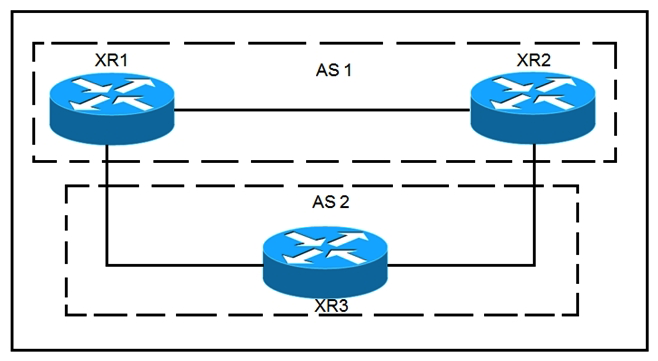 Refer to the exhibit. XR1 and XR2 are sending the prefix 10.11.11.0/24 to XR3. A configured policy on XR1 is incorrectly prepending AS path 11 11 12 12 onto this prefix. A network operator wants to add a policy onto XR3 that will not allow the falsely prepending prefix from being installed. Which policy configuration applied to the XR3 neighbor configuration for XR1 can accomplish this requirement without impact to other or future received routes?
Refer to the exhibit. XR1 and XR2 are sending the prefix 10.11.11.0/24 to XR3. A configured policy on XR1 is incorrectly prepending AS path 11 11 12 12 onto this prefix. A network operator wants to add a policy onto XR3 that will not allow the falsely prepending prefix from being installed. Which policy configuration applied to the XR3 neighbor configuration for XR1 can accomplish this requirement without impact to other or future received routes?A)
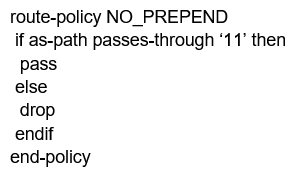
B)
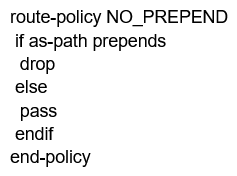
C)
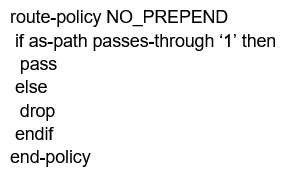
D)
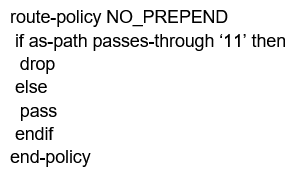

Unlock Deck
Unlock for access to all 74 flashcards in this deck.
Unlock Deck
k this deck
11
You have configured MSDP peering between two autonomous systems that pass traffic between two sites, but the peering has failed to come up. Which task do you perform to begin troubleshooting the problem?
A) Verify that multicast has been disabled globally
B) Verify that PIM-DM is configured on the source interface
C) Verify that both source interfaces are reachable from both peers
D) Verify that the two MSDP peers allow asymmetric routing
A) Verify that multicast has been disabled globally
B) Verify that PIM-DM is configured on the source interface
C) Verify that both source interfaces are reachable from both peers
D) Verify that the two MSDP peers allow asymmetric routing

Unlock Deck
Unlock for access to all 74 flashcards in this deck.
Unlock Deck
k this deck
12
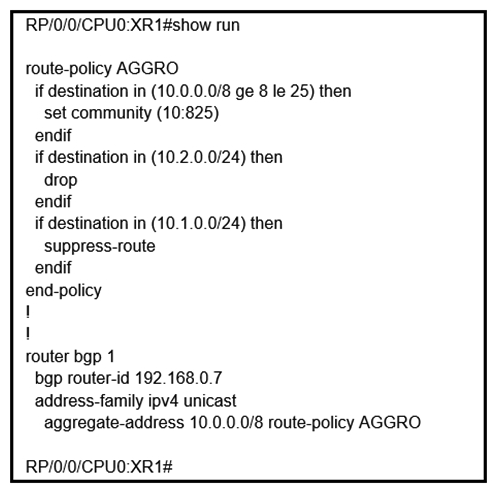 Refer to the exhibit. A network operator is working to filter routes from being advertised that are covered under an aggregate announcement. The receiving router of the aggregate announcement block is still getting some of the more specific routes plus the aggregate. Which configuration change ensures that only the aggregate is announced now and in the future if other networks are to be added?
Refer to the exhibit. A network operator is working to filter routes from being advertised that are covered under an aggregate announcement. The receiving router of the aggregate announcement block is still getting some of the more specific routes plus the aggregate. Which configuration change ensures that only the aggregate is announced now and in the future if other networks are to be added?A) Configure the summary-only keyword on the aggregate command Configure the summary-only keyword on the aggregate command
B) Set each specific route in the AGGRO policy to drop instead of suppress-route
C) Filter the routes on the receiving router
D) Set each specific route in the AGGRO policy to remove instead of suppress-route

Unlock Deck
Unlock for access to all 74 flashcards in this deck.
Unlock Deck
k this deck
13
Which feature is used in multicast routing to prevent loops?
A) STP
B) inverse ARP
C) RPF
D) split horizon
A) STP
B) inverse ARP
C) RPF
D) split horizon

Unlock Deck
Unlock for access to all 74 flashcards in this deck.
Unlock Deck
k this deck
14
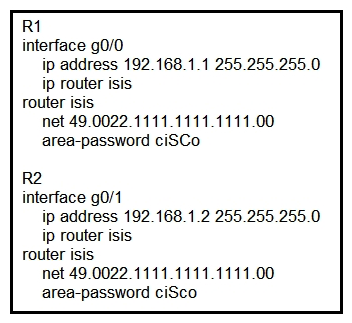 Refer to the exhibit. After you applied these configurations to routers R1 and R2, the two devices could not form a neighbor relationship. Which reason for the problem is the most likely?
Refer to the exhibit. After you applied these configurations to routers R1 and R2, the two devices could not form a neighbor relationship. Which reason for the problem is the most likely?A) The two routers cannot authenticate with one another.
B) The two routers have the same area ID.
C) The two routers have the same network ID.
D) The two routers have different IS-types.

Unlock Deck
Unlock for access to all 74 flashcards in this deck.
Unlock Deck
k this deck
15
What is used by SR-TE to steer traffic through the network?
A) shortest path calculated by IGP
B) dynamic rules
C) path policy
D) explicit maps
A) shortest path calculated by IGP
B) dynamic rules
C) path policy
D) explicit maps

Unlock Deck
Unlock for access to all 74 flashcards in this deck.
Unlock Deck
k this deck
16
Which two conditions must be met before separate ISPs can provide interdomain multicast routing? (Choose two.)
A) Each ISP must configure MSDP to connect its individual multicast administrative domain to the domains at other ISPs.
B) Each ISP must dedicate a single router to handle multicast traffic between providers.
C) Each ISP must replace its RP assignment with a global RP.
D) Each ISP must configure its network to use PIM-DM.
E) Each ISP must support intradomain multicast routing.
A) Each ISP must configure MSDP to connect its individual multicast administrative domain to the domains at other ISPs.
B) Each ISP must dedicate a single router to handle multicast traffic between providers.
C) Each ISP must replace its RP assignment with a global RP.
D) Each ISP must configure its network to use PIM-DM.
E) Each ISP must support intradomain multicast routing.

Unlock Deck
Unlock for access to all 74 flashcards in this deck.
Unlock Deck
k this deck
17
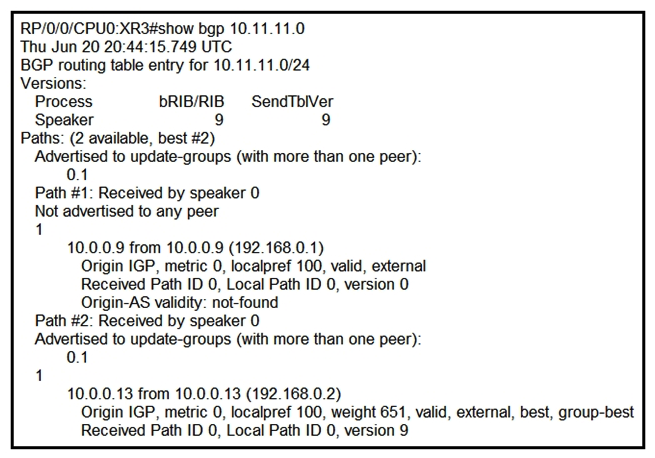 Refer to the exhibit. A network operator is getting the route for 10.11.11 0/24 from two upstream providers on #XR3. The network operator must configure #XR3 to force the 10.11.11.0/24 prefix to route via next hop of 10.0.0.9 as primary when available. Which of these can the operator use the routing policy language for, to enforce this traffic forwarding path?
Refer to the exhibit. A network operator is getting the route for 10.11.11 0/24 from two upstream providers on #XR3. The network operator must configure #XR3 to force the 10.11.11.0/24 prefix to route via next hop of 10.0.0.9 as primary when available. Which of these can the operator use the routing policy language for, to enforce this traffic forwarding path?A) weight of 0 on the prefix coming from 192.168.0.2
B) lower local preference on the prefix coming from 192.168.0.2
C) higher local preference on the prefix coming from 192.168.0.1
D) weight of 100 on the prefix coming from 192.168.0.1

Unlock Deck
Unlock for access to all 74 flashcards in this deck.
Unlock Deck
k this deck
18
 Refer to the exhibit. Why is neighbor 10.1.5.5 stuck in "2WAY" state?
Refer to the exhibit. Why is neighbor 10.1.5.5 stuck in "2WAY" state?A) Router ID 10.1.5.5 is not reachable from R2
B) OSPF authentication has failed between R2 and 10.1.5.5
C) It is an expected behavior when OSPF network type is broadcast
D) OSPF parameters (Area ID or hello interval) are mismatched between R2 and 10.1.5.5

Unlock Deck
Unlock for access to all 74 flashcards in this deck.
Unlock Deck
k this deck
19
Refer to the exhibit. Which LSA type is indicated by this router output? 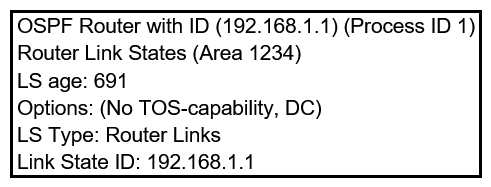
A) type 3 LSA
B) type 4 LSA
C) type 1 LSA
D) type 2 LSA

A) type 3 LSA
B) type 4 LSA
C) type 1 LSA
D) type 2 LSA

Unlock Deck
Unlock for access to all 74 flashcards in this deck.
Unlock Deck
k this deck
20
You have configured routing policies on a Cisco IOS XR device with routing policy language. Which two statements about the routing policies are true? (Choose two.)
A) The routing policies affect BGP-related routes only.
B) If you make edits to an existing routing policy without pasting the full policy into the CLI, the previous policy is overwritten.
C) You can change an existing routing policy by editing individual statements.
D) The routing policies are implemented in a sequential manner.
E) The routing policies are implemented using route maps.
A) The routing policies affect BGP-related routes only.
B) If you make edits to an existing routing policy without pasting the full policy into the CLI, the previous policy is overwritten.
C) You can change an existing routing policy by editing individual statements.
D) The routing policies are implemented in a sequential manner.
E) The routing policies are implemented using route maps.

Unlock Deck
Unlock for access to all 74 flashcards in this deck.
Unlock Deck
k this deck
21
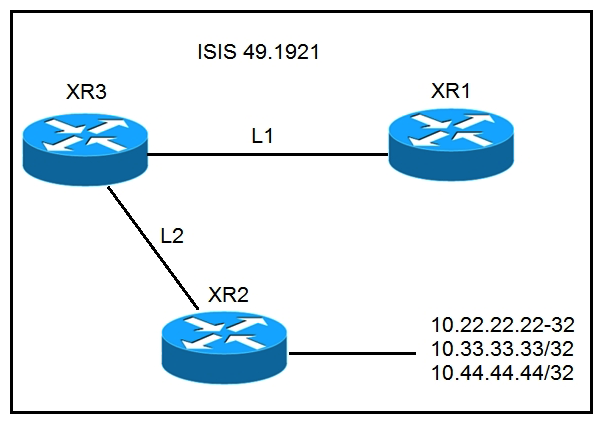 Refer to the exhibit. A network operator must stop 10.33.33.33/32 from being redistributed into Level 1 router XR1. Which configuration meets this need?
Refer to the exhibit. A network operator must stop 10.33.33.33/32 from being redistributed into Level 1 router XR1. Which configuration meets this need?A)
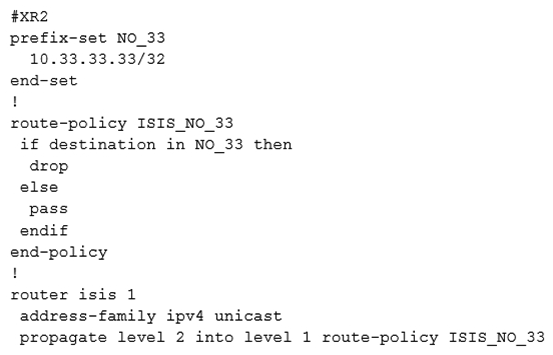
B)

C)

D)
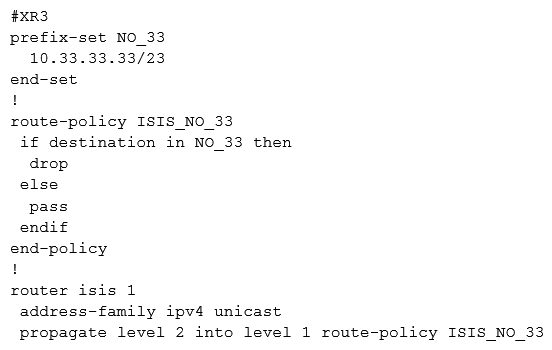

Unlock Deck
Unlock for access to all 74 flashcards in this deck.
Unlock Deck
k this deck
22
 Refer to the exhibit. Which task must you perform on interface g1/0/0 to complete the SSM implementation?
Refer to the exhibit. Which task must you perform on interface g1/0/0 to complete the SSM implementation?A) configure OSPFv3
B) enable CDP
C) disable IGMP
D) configure IGMPv3

Unlock Deck
Unlock for access to all 74 flashcards in this deck.
Unlock Deck
k this deck
23
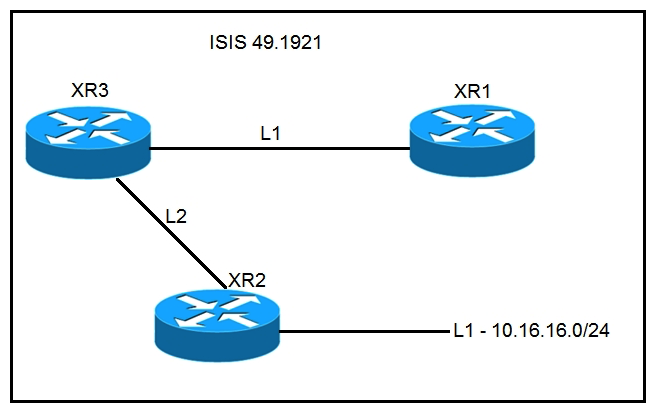 Refer to the exhibit. A network operator must inject a Level 1 route from XR2 (10.16.16.0/24) into the ISIS topology. Which configuration allows the injection in a way that XR3 and XR1 have a valid and working route for 10.16.16.0/24?
Refer to the exhibit. A network operator must inject a Level 1 route from XR2 (10.16.16.0/24) into the ISIS topology. Which configuration allows the injection in a way that XR3 and XR1 have a valid and working route for 10.16.16.0/24?A)

B)
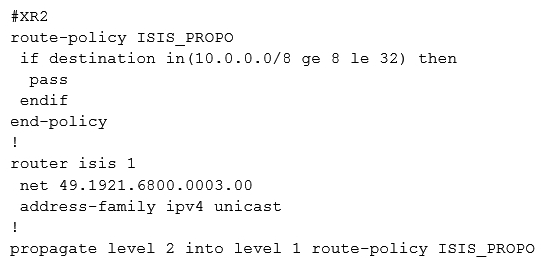
C)
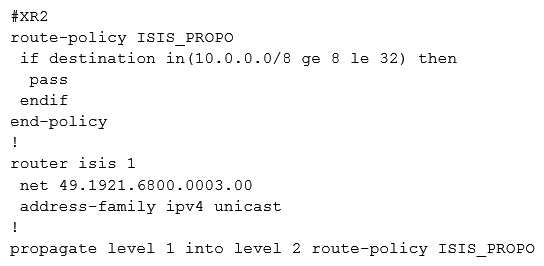
D)
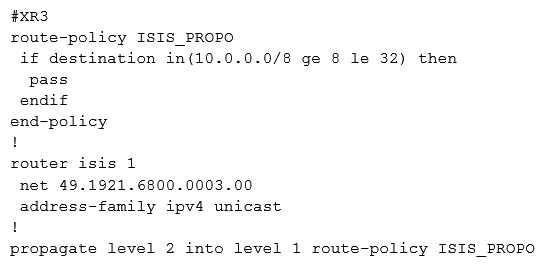

Unlock Deck
Unlock for access to all 74 flashcards in this deck.
Unlock Deck
k this deck
24
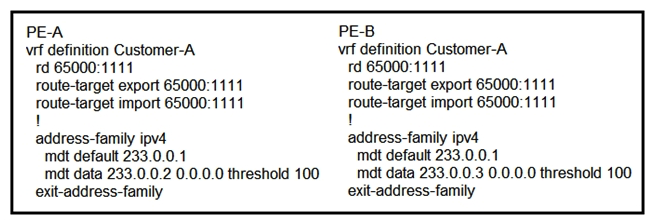 Refer to the exhibit. Which tree does multicast traffic follow?
Refer to the exhibit. Which tree does multicast traffic follow?A) shared tree
B) MDT default
C) source tree
D) MDT voice

Unlock Deck
Unlock for access to all 74 flashcards in this deck.
Unlock Deck
k this deck
25
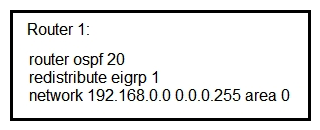 Refer to the exhibit. An engineer is troubleshooting an OSPF issue. Router 1 has a neighbor relationship with router 2. Only router 1 classful EIGRP routes can be seen on router 2. In order for all EIGRP routes to be redistributed correctly, which action should be taken?
Refer to the exhibit. An engineer is troubleshooting an OSPF issue. Router 1 has a neighbor relationship with router 2. Only router 1 classful EIGRP routes can be seen on router 2. In order for all EIGRP routes to be redistributed correctly, which action should be taken?A) Router 1 must have the keyword subnets included in the redistribution command for all EIGRP routes to be redistributed. Router 1 must have the keyword subnets included in the redistribution command for all EIGRP routes to be redistributed.
B) Router 1 must remove the AS number 1 from the redistribution command for all EIGRP routes to be redistributed.
C) Router 1 must have the keyword ospf-metric included in the redistribution command for all EIGRP routes to be redistributed. ospf-metric
D) Router 1 must have the keyword metric-type 1 included in the redistribution command for all EIGRP routes to be redistributed. metric-type 1 included in the redistribution command for all EIGRP routes to be redistributed.

Unlock Deck
Unlock for access to all 74 flashcards in this deck.
Unlock Deck
k this deck
26
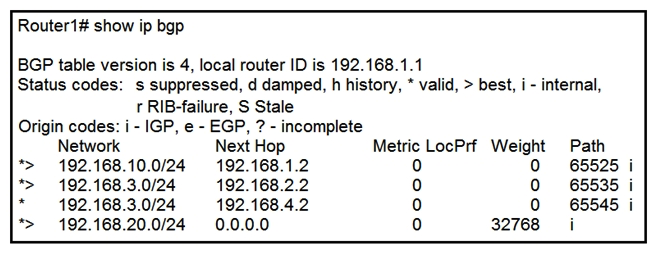 Refer to the exhibit. Which attribute can router 1 alter so that only other iBGP peers prefer to use 192.168.4.2 as the next hop for route 192.168.3.0/24?
Refer to the exhibit. Which attribute can router 1 alter so that only other iBGP peers prefer to use 192.168.4.2 as the next hop for route 192.168.3.0/24?A) MED
B) local preference
C) origin
D) weight

Unlock Deck
Unlock for access to all 74 flashcards in this deck.
Unlock Deck
k this deck
27
Which cost is the default when redistributing routes from BGP to OSPF?
A) 20
B) 1
C) infinite
D) automatic
A) 20
B) 1
C) infinite
D) automatic

Unlock Deck
Unlock for access to all 74 flashcards in this deck.
Unlock Deck
k this deck
28
Which two characteristics unique to SSM when compared to ASM are true? (Choose two.)
A) It uses SPT switchover
B) It uses (*,G) exclusively
C) It uses IGMPv3
D) It uses RP
E) It uses (S,G) exclusively
A) It uses SPT switchover
B) It uses (*,G) exclusively
C) It uses IGMPv3
D) It uses RP
E) It uses (S,G) exclusively

Unlock Deck
Unlock for access to all 74 flashcards in this deck.
Unlock Deck
k this deck
29
Which command is used to enable BIDIR-PIM under global configuration mode for Cisco IOS XE Sofware?
A) ip pim bidir-enable
B) ipv4 pim bidir-enable
C) ip multicast-routing
D) ip pim bidir
A) ip pim bidir-enable
B) ipv4 pim bidir-enable
C) ip multicast-routing
D) ip pim bidir

Unlock Deck
Unlock for access to all 74 flashcards in this deck.
Unlock Deck
k this deck
30
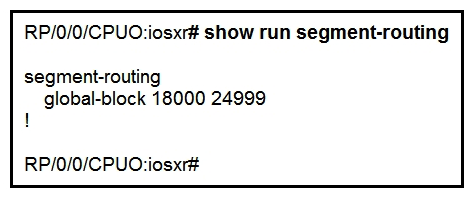 Refer to the exhibit. A network engineer implemented this segment routing configuration. Which statement about the output is true?
Refer to the exhibit. A network engineer implemented this segment routing configuration. Which statement about the output is true?A) This range conflicts with the segment routing local block range.
B) The device must be reloaded for these ranges to be allocated and used.
C) The default segment routing global block range is being used on this device.
D) A nondefault segment routing global block range is being used on this device.

Unlock Deck
Unlock for access to all 74 flashcards in this deck.
Unlock Deck
k this deck
31
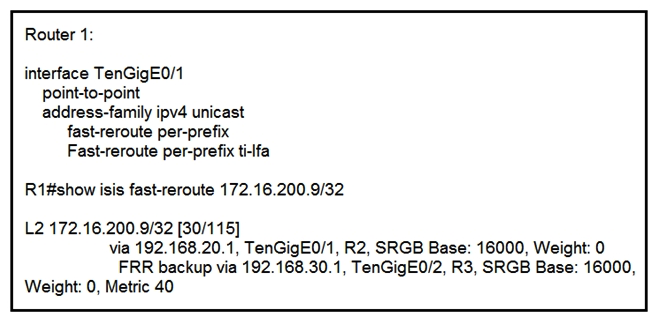 Refer to the exhibit. Router 1 is connected to router 2 on interface TenGigE0/1. Which interface provides the alternate path to 172.16.200.9/32 when the link between router 1 and router 2 goes down?
Refer to the exhibit. Router 1 is connected to router 2 on interface TenGigE0/1. Which interface provides the alternate path to 172.16.200.9/32 when the link between router 1 and router 2 goes down?A) TenGigE0/1 interface provides the alternate path
B) A backup path must be statically installed
C) TenGigE0/2 interface provides the alternate path
D) A primary path must be manually installed

Unlock Deck
Unlock for access to all 74 flashcards in this deck.
Unlock Deck
k this deck
32
A network consultant is troubleshooting IS-IS instances to identify why a routing domains is having communication problems between the two instances. Which description of the possible cause of issues in the routing domain is true?
A) The same interface cannot be advertised in two different IS-IS instances
B) The IS-IS "ISP" and "ISP2" instances are unrelated and unable to intercommunicate
C) The configured IS-IS NSEL value is not allowing the routing systems to establish a neighborship
D) The interface mode ip router is-is command was not included in the script The interface mode ip router is-is command was not included in the script
A) The same interface cannot be advertised in two different IS-IS instances
B) The IS-IS "ISP" and "ISP2" instances are unrelated and unable to intercommunicate
C) The configured IS-IS NSEL value is not allowing the routing systems to establish a neighborship
D) The interface mode ip router is-is command was not included in the script The interface mode ip router is-is command was not included in the script

Unlock Deck
Unlock for access to all 74 flashcards in this deck.
Unlock Deck
k this deck
33
In a PIM-SM environment, which mechanism determines the traffic that a receiver receives?
A) The receiver explicitly requests its desired traffic from the RP on the shared tree.
B) The receiver explicitly requests traffic from a single source, which responds by forwarding all traffic.
C) The RP on the shared tree floods traffic out of all PIM configured interfaces.
D) The receiver explicitly requests traffic from each desired source, which responds by sending all traffic.
A) The receiver explicitly requests its desired traffic from the RP on the shared tree.
B) The receiver explicitly requests traffic from a single source, which responds by forwarding all traffic.
C) The RP on the shared tree floods traffic out of all PIM configured interfaces.
D) The receiver explicitly requests traffic from each desired source, which responds by sending all traffic.

Unlock Deck
Unlock for access to all 74 flashcards in this deck.
Unlock Deck
k this deck
34
Which output from the show isis interface command helps an engineer troubleshoot an IS-IS adjacency problem on a Cisco IOS-XR platform?
A) metric
B) priority
C) circuit type
D) hello interval
A) metric
B) priority
C) circuit type
D) hello interval

Unlock Deck
Unlock for access to all 74 flashcards in this deck.
Unlock Deck
k this deck
35
A network engineer is troubleshooting OSPF multiarea. Which Cisco IOS XR feature should the engineer use in order to streamline OSPF issue?
A) hierarchical CLI
B) DR support for topology management
C) routing process enabled by default on all interfaces
D) show ip ospf topology command show ip ospf topology command
A) hierarchical CLI
B) DR support for topology management
C) routing process enabled by default on all interfaces
D) show ip ospf topology command show ip ospf topology command

Unlock Deck
Unlock for access to all 74 flashcards in this deck.
Unlock Deck
k this deck
36
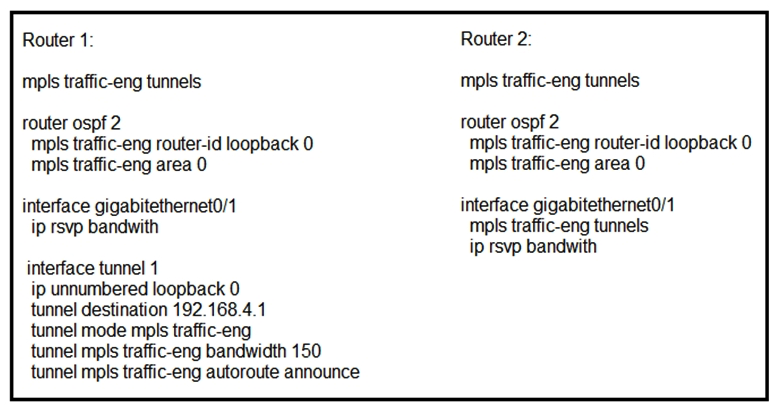 Refer to the exhibit. Router 1 has attempted to establish a Cisco MPLS TE tunnel to router 2, but the tunnel has failed. Which statement about this configuration is true?
Refer to the exhibit. Router 1 has attempted to establish a Cisco MPLS TE tunnel to router 2, but the tunnel has failed. Which statement about this configuration is true?A) Router 1 must define an explicit path to router 2
B) Router 1 and router 2 must define the RSVP bandwidth reserved on the physical interfaces
C) Router 2 must have a tunnel interface created with router 1 as the destination
D) Router 1 must have Cisco MPLS TE enabled on interface gigabitethernet0/1

Unlock Deck
Unlock for access to all 74 flashcards in this deck.
Unlock Deck
k this deck
37
What can be used to determine a path from the head-end to a tail-end router when implementing SR-TE with a head-end, with little information on the network topology?
A) traffic controller
B) path computation engine
C) tail-end router
D) SNMP server
A) traffic controller
B) path computation engine
C) tail-end router
D) SNMP server

Unlock Deck
Unlock for access to all 74 flashcards in this deck.
Unlock Deck
k this deck
38
Which statement about BFD on Cisco IOS XR Software is true?
A) Cisco IOS XR router must use LDP to route back to the Cisco IOS router to establish the peer relationship.
B) Cisco IOS XR Software does not support BFD multihop for IPv4.
C) Cisco IOS XR router must use dynamic routing or a static route back to the Cisco IOS router to establish the peer relationship.
D) BFD is not compatible between Cisco IOS XR and Cisco IOS Software.
A) Cisco IOS XR router must use LDP to route back to the Cisco IOS router to establish the peer relationship.
B) Cisco IOS XR Software does not support BFD multihop for IPv4.
C) Cisco IOS XR router must use dynamic routing or a static route back to the Cisco IOS router to establish the peer relationship.
D) BFD is not compatible between Cisco IOS XR and Cisco IOS Software.

Unlock Deck
Unlock for access to all 74 flashcards in this deck.
Unlock Deck
k this deck
39
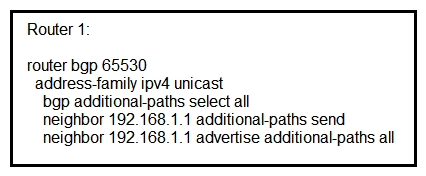 Refer to the exhibit. Which statement about this configuration is true?
Refer to the exhibit. Which statement about this configuration is true?A) Router 1 sends and receives multiple best paths from neighbor 192.168.1.1
B) Router 1 sends up to two paths to neighbor 192.168.1.1 for all routes
C) Router 1 receives up to two paths from neighbor 192.168.1.1 for all routes in the same AS
D) Router 1 receives only the best path from neighbor 192.168.1.1

Unlock Deck
Unlock for access to all 74 flashcards in this deck.
Unlock Deck
k this deck
40
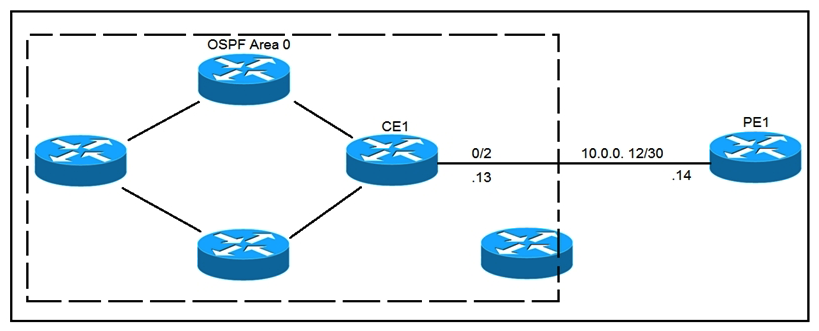 Refer to the exhibit. CE1 is the gateway router into the provider network via PE1. A network operator must inject a default route into OSPF area 0. All devices inside area 0 must be able to reach PE1. Which configuration achieves this goal?
Refer to the exhibit. CE1 is the gateway router into the provider network via PE1. A network operator must inject a default route into OSPF area 0. All devices inside area 0 must be able to reach PE1. Which configuration achieves this goal?A)

B)

C)

D)


Unlock Deck
Unlock for access to all 74 flashcards in this deck.
Unlock Deck
k this deck
41
 Refer to the exhibit. Which two commands must the engineer configure for the company's PIM-SM network to enable Auto-RP mappings to be sent over the FastEthernet0/0 interface, without affecting normal operation? (Choose two.)
Refer to the exhibit. Which two commands must the engineer configure for the company's PIM-SM network to enable Auto-RP mappings to be sent over the FastEthernet0/0 interface, without affecting normal operation? (Choose two.)A) enable auto-rp listener
B) enable sparse-mode
C) enable Auto-RP announcements
D) enable sparse-dense mode
E) enable dense mode

Unlock Deck
Unlock for access to all 74 flashcards in this deck.
Unlock Deck
k this deck
42
 Refer to the exhibit. After troubleshooting BGP traffic steering issue, which action did the network operator take to achieve the correct effect of this configuration?
Refer to the exhibit. After troubleshooting BGP traffic steering issue, which action did the network operator take to achieve the correct effect of this configuration?A) Routes that have passed through AS 65517 have the local preference set to 150.
B) Routes that have originated through AS 65517 have the local preference set to 150.
C) Routes directly attached to AS 65517 have the local preference set to 150.
D) Routes that have passed through AS 65517 have the local preference set to 150 and the traffic is denied.

Unlock Deck
Unlock for access to all 74 flashcards in this deck.
Unlock Deck
k this deck
43
After an engineer configures BGP in R1, it starts receiving this message:  Which action makes the peering come back up again?
Which action makes the peering come back up again?
A) Make a soft reset to the peer
B) Set up a hello timer higher
C) Set up a hold-down timer higher
D) Set up a minimum hold-down timer higher
 Which action makes the peering come back up again?
Which action makes the peering come back up again?A) Make a soft reset to the peer
B) Set up a hello timer higher
C) Set up a hold-down timer higher
D) Set up a minimum hold-down timer higher

Unlock Deck
Unlock for access to all 74 flashcards in this deck.
Unlock Deck
k this deck
44
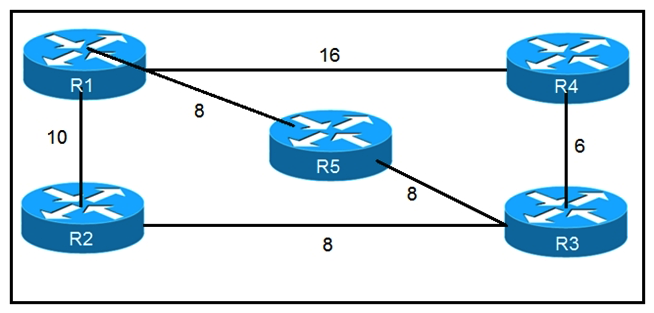 Refer to the exhibit. Which router does R1 install as an alternate next hop when trying to reach R3 if LFA is enabled?
Refer to the exhibit. Which router does R1 install as an alternate next hop when trying to reach R3 if LFA is enabled?A) R5
B) R3
C) R4
D) R2

Unlock Deck
Unlock for access to all 74 flashcards in this deck.
Unlock Deck
k this deck
45
What are the two characteristics of route reflectors? (Choose two.)
A) If a route reflector receives a route with a cluster-list attribute containing a different cluster ID, the route is discarded
B) If a router received an iBGP route with the originator-ID attribute set to its own router ID, the route is discarded
C) Routes received from a route reflector client are reflected to other clients and nonclient peers
D) Routes received from nonclient peers are reflected to route reflector cluster as well as OSPF peers
E) Routes received from nonclient peers are reflected to route reflector clients as well as nonclient peers
A) If a route reflector receives a route with a cluster-list attribute containing a different cluster ID, the route is discarded
B) If a router received an iBGP route with the originator-ID attribute set to its own router ID, the route is discarded
C) Routes received from a route reflector client are reflected to other clients and nonclient peers
D) Routes received from nonclient peers are reflected to route reflector cluster as well as OSPF peers
E) Routes received from nonclient peers are reflected to route reflector clients as well as nonclient peers

Unlock Deck
Unlock for access to all 74 flashcards in this deck.
Unlock Deck
k this deck
46
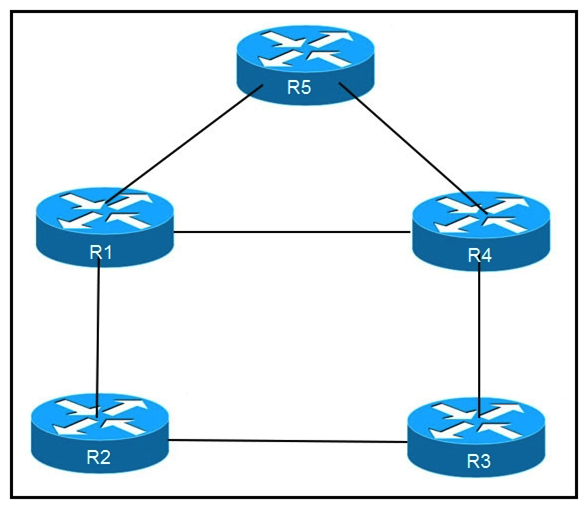 Refer to the exhibit. An engineer is addressing an IS-IS design issue which is running within the topology. All links are running on FastEthernet, except the link between R5 and R4, which is Gigabit Ethernet. Which statement about the design is true?
Refer to the exhibit. An engineer is addressing an IS-IS design issue which is running within the topology. All links are running on FastEthernet, except the link between R5 and R4, which is Gigabit Ethernet. Which statement about the design is true?A) R4 prefer to reach R5 using R1 as the next hop
B) All links have equal cost if the default metric is used
C) R5 prefers to use R4 as the next hop for all routes
D) R1 prefer to use R5 as the next hop to reach R4

Unlock Deck
Unlock for access to all 74 flashcards in this deck.
Unlock Deck
k this deck
47
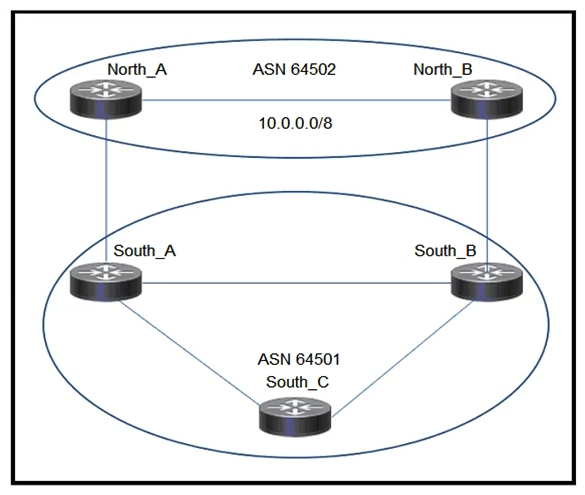 Refer to the exhibit. A network engineer sets up a multihoming eBGP topology where multiple Autonomous Systems connect to ASN 64501. The engineer wants to block all the routes coming from ASN 64502 but allow all the others. For that purpose, the following AS Path prefix list is being used: (config)#ip as-path access-list 10 deny _64502$ What must be fixed to achieve this result?
Refer to the exhibit. A network engineer sets up a multihoming eBGP topology where multiple Autonomous Systems connect to ASN 64501. The engineer wants to block all the routes coming from ASN 64502 but allow all the others. For that purpose, the following AS Path prefix list is being used: (config)#ip as-path access-list 10 deny _64502$ What must be fixed to achieve this result?A) The AS-PATH filter must be defined inside the route-map mode
B) The statement must be modified with ip as-path access-list 1 deny_64502_ The statement must be modified with ip as-path access-list 1 deny_64502_
C) The statement must be modified with ip as-path access-list 1 deny ^64502$
D) At the end, ip as-path access-list 10 permit.* must be included At the end, ip as-path access-list 10 permit.* must be included

Unlock Deck
Unlock for access to all 74 flashcards in this deck.
Unlock Deck
k this deck
48
For which reason do you deploy BGP confederations within a BGP transit backbone?
A) to support a larger number of eBGP peer sessions
B) to increase the number of routes that can be redistributed between the running IGP and BGP
C) to reduce the number of eBGP routes that must be shared between autonomous systems
D) to reduce the number of iBGP peering sessions
A) to support a larger number of eBGP peer sessions
B) to increase the number of routes that can be redistributed between the running IGP and BGP
C) to reduce the number of eBGP routes that must be shared between autonomous systems
D) to reduce the number of iBGP peering sessions

Unlock Deck
Unlock for access to all 74 flashcards in this deck.
Unlock Deck
k this deck
49
Which difference should be considered when intradomain or interdomain multicast routing is implemented?
A) Interdomain multicast routing relies on PIM-DM, and intradomain multicast routing relies on PIM-SM
B) Interdomain multicast routing uses BIDR-PIM to establish neighbor relationships between AS, and intradomain multicast routing uses MSDP
C) A network uses intradomain multicast routing without interdomain routing, but networks that use interdomain multicast routing must also apply intradomain routing
D) Interdomain multicast routing requires an IS-IS or OSPF neighbor relationship between the domains, but intradomain multicast routing requires only BGP
A) Interdomain multicast routing relies on PIM-DM, and intradomain multicast routing relies on PIM-SM
B) Interdomain multicast routing uses BIDR-PIM to establish neighbor relationships between AS, and intradomain multicast routing uses MSDP
C) A network uses intradomain multicast routing without interdomain routing, but networks that use interdomain multicast routing must also apply intradomain routing
D) Interdomain multicast routing requires an IS-IS or OSPF neighbor relationship between the domains, but intradomain multicast routing requires only BGP

Unlock Deck
Unlock for access to all 74 flashcards in this deck.
Unlock Deck
k this deck
50
After you change the IP address on an IOS XR router, you cannot ping the new address. Which step did you forget to complete?
A) commit the configuration
B) roll back the configuration
C) merge the configuration
D) save the running configuration
A) commit the configuration
B) roll back the configuration
C) merge the configuration
D) save the running configuration

Unlock Deck
Unlock for access to all 74 flashcards in this deck.
Unlock Deck
k this deck
51
 Refer to the exhibit. CE1 and CE2 cannot communicate through the service provider BGP peering is established between PE1 and PE2. IS-IS is the only routing protocol running in the service provider core. What step can be done to troubleshoot the issue?
Refer to the exhibit. CE1 and CE2 cannot communicate through the service provider BGP peering is established between PE1 and PE2. IS-IS is the only routing protocol running in the service provider core. What step can be done to troubleshoot the issue?A) Switch the IGPs running in the core from IS-IS to OSPF to support a Cisco MPLS TE tunnel from PE1 to PE2.
B) Configure BGP between CE and PE routers.
C) Confirm that IS-IS is running with metric-style narrow.
D) Verify the MPLS LSPs.

Unlock Deck
Unlock for access to all 74 flashcards in this deck.
Unlock Deck
k this deck
52
 Refer to the exhibit. A network engineer applied configuration on R1 to summarize all ISIS routes, but R2 is still receiving specific routes from R1. The engineer has confirmed that both routers are configured with the correct summarization configuration, but R1 is not sending the correct summary routes. Which configuration must be applied to router R1 to summarize routes within Level 1?
Refer to the exhibit. A network engineer applied configuration on R1 to summarize all ISIS routes, but R2 is still receiving specific routes from R1. The engineer has confirmed that both routers are configured with the correct summarization configuration, but R1 is not sending the correct summary routes. Which configuration must be applied to router R1 to summarize routes within Level 1?A) R1(config-router)# no summary-address 1.0.0.0 255.0.0.0 level-1 R1(config-router)# no summary-address 1.0.0.0 255.0.0.0 level-1
B) R1(config-router)# summary-address 1.0.0.0 255.0.0.0 level-2 summary-address 1.0.0.0 255.0.0.0 level-2
C) R1(config-router)# summary-address 1.0.0.0 255.0.0.0 level-1-2 summary-address 1.0.0.0 255.0.0.0 level-1-2
D) R1(config-router)# summary-address 1.0.0.0 255.0.0.0 level-1 summary-address 1.0.0.0 255.0.0.0 level-1

Unlock Deck
Unlock for access to all 74 flashcards in this deck.
Unlock Deck
k this deck
53
Which two statements about route reflectors are true? (Choose two.)
A) Routes received from nonclient peers are reflected to route reflector clients as well as nonclient peers.
B) Routes received from nonclient peers are reflected to route reflector cluster as well as OSPF peers.
C) If a router received an iBGP route with the originator-ID attribute set to its own router ID, the route is discarded.
D) Routes received from a route reflector client is reflected to other clients and nonclient peers.
E) If a route reflector receives a route with a cluster-list attribute containing a different cluster ID, the route is discarded.
A) Routes received from nonclient peers are reflected to route reflector clients as well as nonclient peers.
B) Routes received from nonclient peers are reflected to route reflector cluster as well as OSPF peers.
C) If a router received an iBGP route with the originator-ID attribute set to its own router ID, the route is discarded.
D) Routes received from a route reflector client is reflected to other clients and nonclient peers.
E) If a route reflector receives a route with a cluster-list attribute containing a different cluster ID, the route is discarded.

Unlock Deck
Unlock for access to all 74 flashcards in this deck.
Unlock Deck
k this deck
54
An engineer is working to implement segment routing protocol on the customer's core network. Which step should the engineer take before the segment routing is enabled and is running with BGP?
A) Segment routing must be configured with EIGRP
B) Segment routing must be configured with ISIS
C) MPLS must be configured
D) Explicit-null must be configured for all neighbors
A) Segment routing must be configured with EIGRP
B) Segment routing must be configured with ISIS
C) MPLS must be configured
D) Explicit-null must be configured for all neighbors

Unlock Deck
Unlock for access to all 74 flashcards in this deck.
Unlock Deck
k this deck
55
An engineer is troubleshooting a connectivity issue across the MPLS network and is verifying the forwarding behavior of packets. Which table does the engineer look at to verify the forwarding behavior of an IP packet as it enters the MPLS network at the ingress LSR?
A) LFIB
B) LIB
C) RIB
D) FIB
A) LFIB
B) LIB
C) RIB
D) FIB

Unlock Deck
Unlock for access to all 74 flashcards in this deck.
Unlock Deck
k this deck
56
Which two routing protocols have extensions capable of running SRv6? (Choose two.)
A) OSPF
B) BGP
C) RIP
D) IGRP
E) EIGRP
A) OSPF
B) BGP
C) RIP
D) IGRP
E) EIGRP

Unlock Deck
Unlock for access to all 74 flashcards in this deck.
Unlock Deck
k this deck
57
 Refer to the exhibit. An administrator is troubleshooting Internet access issues on a customer's network. After applying this ISIS configuration to R1, the administrator notices that it fails to redistribute the default route into IS-IS. After checking the connectivity between the ISIS router and the ISP router the engineer confirmed there is Layer 3 connectivity between them. Which action should be taken to correct the problem?
Refer to the exhibit. An administrator is troubleshooting Internet access issues on a customer's network. After applying this ISIS configuration to R1, the administrator notices that it fails to redistribute the default route into IS-IS. After checking the connectivity between the ISIS router and the ISP router the engineer confirmed there is Layer 3 connectivity between them. Which action should be taken to correct the problem?A) Configure R1 as a Layer 1 router
B) Add the default-information originate command to the configuration Add the default-information originate command to the configuration
C) ?onfigure the default route under any routing protocol other than IS-IS
D) Associate the default route with a VRF

Unlock Deck
Unlock for access to all 74 flashcards in this deck.
Unlock Deck
k this deck
58
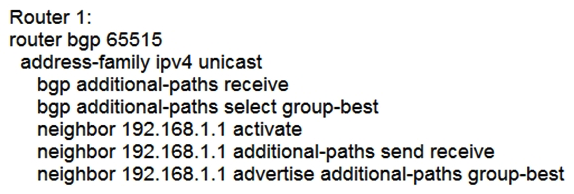 Refer to the exhibit. An engineer working for a private telecommunication company with an employee id: 1234:09:567 implemented this configuration on Router1, what is the effect of it?
Refer to the exhibit. An engineer working for a private telecommunication company with an employee id: 1234:09:567 implemented this configuration on Router1, what is the effect of it?A) Router 1 receives only one best path from neighbor 192.168.1.1
B) Router 1 sends only one best path to neighbor 192.168.1.1
C) Router 1 sends up to three paths to neighbor 192.168.1.1 for all routes
D) Router 1 sends and receives multiple best paths from neighbor 192.168.1.1

Unlock Deck
Unlock for access to all 74 flashcards in this deck.
Unlock Deck
k this deck
59
For which reason can two BGP peers fail to establish a neighbor relationship?
A) Their BGP send-community strings are misconfigured
B) Their BGP timers are mismatched
C) Their remote-as numbers are misconfigured
D) They are both activated under an IPv4 address family
A) Their BGP send-community strings are misconfigured
B) Their BGP timers are mismatched
C) Their remote-as numbers are misconfigured
D) They are both activated under an IPv4 address family

Unlock Deck
Unlock for access to all 74 flashcards in this deck.
Unlock Deck
k this deck
60
 Refer to the exhibit. A service provider technician is working on a multicast issue for a customer. While checking the multicast table, the technician notices that no flags are present for the (1.1.1.1, 239.1.1.1) entry, yet flags are present for the (1.1.1.1, 232.1.1.1) entry. Which factor might explain this issue?
Refer to the exhibit. A service provider technician is working on a multicast issue for a customer. While checking the multicast table, the technician notices that no flags are present for the (1.1.1.1, 239.1.1.1) entry, yet flags are present for the (1.1.1.1, 232.1.1.1) entry. Which factor might explain this issue?A) Only the administratively scoped range is permitted
B) Only ASM is permitted
C) Only the default SSM range is permitted
D) Only GLOP is permitted

Unlock Deck
Unlock for access to all 74 flashcards in this deck.
Unlock Deck
k this deck
61
 Refer to the exhibit. Routers within the cluster are not receiving the desired prefixes. What must be done to fix the issue?
Refer to the exhibit. Routers within the cluster are not receiving the desired prefixes. What must be done to fix the issue?A) Clients in that cluster must have full mesh connectivity between eBGP peers
B) No client-to-client reflection must be enabled
C) Clients in that cluster must have full mesh connectivity between iBGP peers
D) No client-to-client must be disabled

Unlock Deck
Unlock for access to all 74 flashcards in this deck.
Unlock Deck
k this deck
62
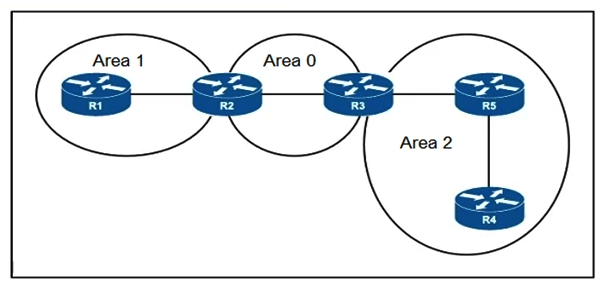 Refer to the exhibit. A network engineer applied configuration on R5 to summarize all OSPF routes, but R4 is still receiving specific routes from R5. The engineer has confirmed that both R5 and R4 routers are configured with correct summarization configuration, but R5 is not sending the summary routes. What action must the engineer take to fix the problem?
Refer to the exhibit. A network engineer applied configuration on R5 to summarize all OSPF routes, but R4 is still receiving specific routes from R5. The engineer has confirmed that both R5 and R4 routers are configured with correct summarization configuration, but R5 is not sending the summary routes. What action must the engineer take to fix the problem?A) Remove summarization configuration on R5 and configure it on R4
B) Clear link-state database on both R4 and R5 routers for summarization to work
C) Configure a sham link between R4 and R5 to support summarization within Area 2
D) Move R4 and R5 in separate areas as now they maintain the same link-state database

Unlock Deck
Unlock for access to all 74 flashcards in this deck.
Unlock Deck
k this deck
63
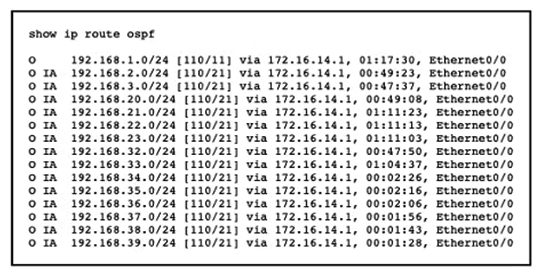 Refer to the exhibit. An engineer applied the summarization configuration on R1 for four networks (192.168.20.0/24 to 192.168.23.0/24) in area 1 and eight networks (192.168.32.0/24 to 192.168.39.0/24) in area 2 to stop the flooding of all the customer routes. While checking the routing table of R2, the engineer noticed that R1 is still sending only specific routes to R2. Which configuration should the engineer apply on R1 to summarize routes?
Refer to the exhibit. An engineer applied the summarization configuration on R1 for four networks (192.168.20.0/24 to 192.168.23.0/24) in area 1 and eight networks (192.168.32.0/24 to 192.168.39.0/24) in area 2 to stop the flooding of all the customer routes. While checking the routing table of R2, the engineer noticed that R1 is still sending only specific routes to R2. Which configuration should the engineer apply on R1 to summarize routes?A)

B)

C)

D)


Unlock Deck
Unlock for access to all 74 flashcards in this deck.
Unlock Deck
k this deck
64
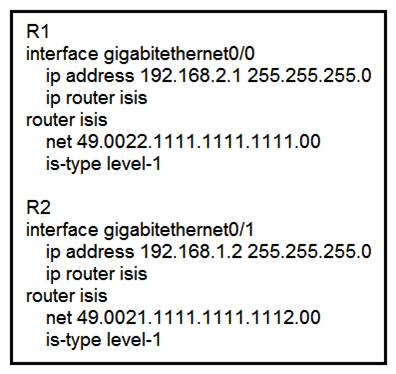 Refer to the exhibit. Routers R1 and R2 cannot form a neighbor relationship, but the network is otherwise configured correctly and operating normally. Which two statements describe the problem? (Choose two.)
Refer to the exhibit. Routers R1 and R2 cannot form a neighbor relationship, but the network is otherwise configured correctly and operating normally. Which two statements describe the problem? (Choose two.)A) The two routers are in the same area
B) The two routers are in different subnets
C) The two routers have password mismatch issues
D) The two routers have the same network ID
E) The two routers are in different areas

Unlock Deck
Unlock for access to all 74 flashcards in this deck.
Unlock Deck
k this deck
65
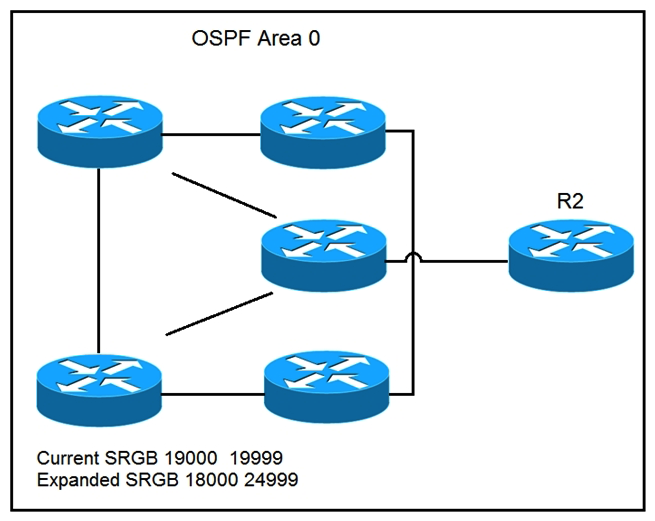 Refer to the exhibit. A network operator wants to expand the segment routing global block in upcoming maintenance. The operator must ensure that the changes to the segment routing global block have no adverse impacts on the prefix-sid associated with the loopback0 interface used within the OSPF domain. Which command can the operator use to enforce R2 to have a strict prefix-sid assignment to loopback0?
Refer to the exhibit. A network operator wants to expand the segment routing global block in upcoming maintenance. The operator must ensure that the changes to the segment routing global block have no adverse impacts on the prefix-sid associated with the loopback0 interface used within the OSPF domain. Which command can the operator use to enforce R2 to have a strict prefix-sid assignment to loopback0?A)

B)

C)

D)
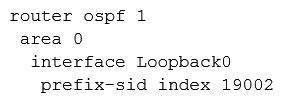

Unlock Deck
Unlock for access to all 74 flashcards in this deck.
Unlock Deck
k this deck
66
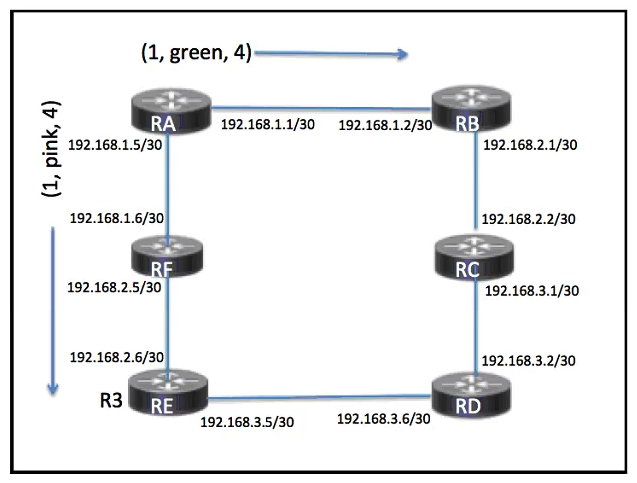 Refer to the exhibit. The green policy is designed with low delay, and the pink policy is designed with low cost. What is the next hop for node A on its way to node D, with the objective of achieving a low delay?
Refer to the exhibit. The green policy is designed with low delay, and the pink policy is designed with low cost. What is the next hop for node A on its way to node D, with the objective of achieving a low delay?A) 192.168.1.2
B) 192.168.3.2
C) 192.168.3.6
D) 192.168.1.6

Unlock Deck
Unlock for access to all 74 flashcards in this deck.
Unlock Deck
k this deck
67
What is the purpose of a BGP confederation?
A) It reduces the number of iBGP peers and increases stability
B) It improves service by increasing the number of simultaneous iBGP peering sessions
C) It redirects traffic away from route reflectors, which reduces their operating load
D) It limits the number of routes a device receives from its peers, which reduces CPU load
A) It reduces the number of iBGP peers and increases stability
B) It improves service by increasing the number of simultaneous iBGP peering sessions
C) It redirects traffic away from route reflectors, which reduces their operating load
D) It limits the number of routes a device receives from its peers, which reduces CPU load

Unlock Deck
Unlock for access to all 74 flashcards in this deck.
Unlock Deck
k this deck
68
Which expression, when used with the as-path-set command, matches the AS path attribute of the route?
A) Length
B) dfa-regex
C) ios-regex
D) neighbor-is
A) Length
B) dfa-regex
C) ios-regex
D) neighbor-is

Unlock Deck
Unlock for access to all 74 flashcards in this deck.
Unlock Deck
k this deck
69
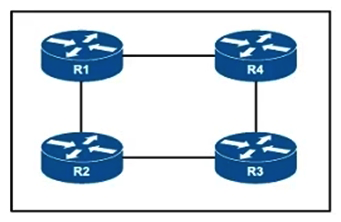 Refer to the exhibit. All routers on this network have been configured with PIM-SM, and R1 is the rendezvous point. However, when asymmetric routing is implemented to modify link usage, the network begins to drop certain multicast traffic. Which action corrects the problem?
Refer to the exhibit. All routers on this network have been configured with PIM-SM, and R1 is the rendezvous point. However, when asymmetric routing is implemented to modify link usage, the network begins to drop certain multicast traffic. Which action corrects the problem?A) Place the routes affected by asymmetric routing in a VRF
B) Remove the asymmetric routing and use spanning tree to manage link usage
C) Add a static mroute for routes that are failing
D) Configure the routers to use PIM-DM instead of PIM-SM

Unlock Deck
Unlock for access to all 74 flashcards in this deck.
Unlock Deck
k this deck
70
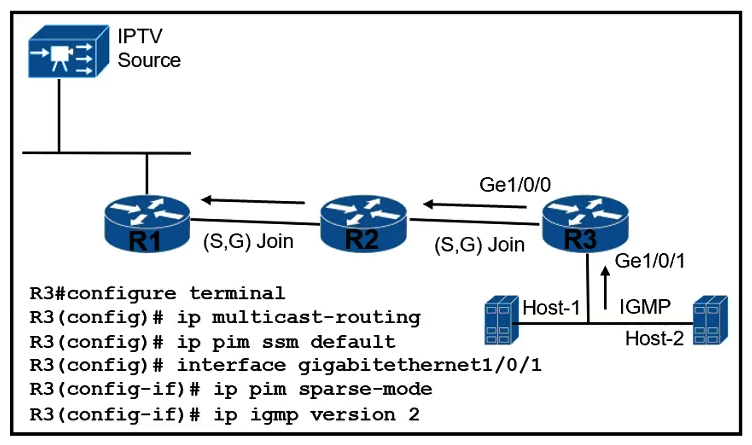 Refer to the exhibit. A customer reports that Host-1 is failing to receive streaming traffic from the IPTV source. The engineer has confirmed that hosts on router R2 are receiving traffic normally and that Host-1 is correctly sending subscription messages to join the IPTV stream. Which action must the engineer take to correct the problem?
Refer to the exhibit. A customer reports that Host-1 is failing to receive streaming traffic from the IPTV source. The engineer has confirmed that hosts on router R2 are receiving traffic normally and that Host-1 is correctly sending subscription messages to join the IPTV stream. Which action must the engineer take to correct the problem?A) Remove IP PIM SSM and IGMP from interface GigabitEthernet 1/0/1 on R3 and configure under global configuration
B) Configure IGMP version 3 under interface GigabitEthernet 1/0/1 on R3
C) Configure IP PIM SSM and IGMP version 2 under interface GigabitEthernet 1/0/1 on R3
D) Remove IP PIM SSM from the global configuration on R3 and configure it under the GigabitEthernet 1/0/1 interface

Unlock Deck
Unlock for access to all 74 flashcards in this deck.
Unlock Deck
k this deck
71
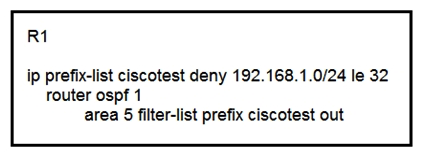 Refer to the exhibit. An engineer applied the configuration on R1 to prevent network 192.168.1.0/24 from being propagated outside of area 5. After the change, users have reported they are not able to access any of the application servers that were working before. While checking the routing table of the peer router, the engineer notices R1 stopped propagating any routes outside area 5. Which action must be taken to fix the problem?
Refer to the exhibit. An engineer applied the configuration on R1 to prevent network 192.168.1.0/24 from being propagated outside of area 5. After the change, users have reported they are not able to access any of the application servers that were working before. While checking the routing table of the peer router, the engineer notices R1 stopped propagating any routes outside area 5. Which action must be taken to fix the problem?A) Change the prefix-list action to permit and add an explicit deny statement for network 192.168.1.0/24 Change the prefix-list action to permit and add an explicit deny statement for network 192.168.1.0/24
B) Add a permit statement for 0.0.0.0/0 le 32 to the end of the prefix-list to override the implicit deny Add a statement for 0.0.0.0/0 le 32 to the end of the prefix-list to override the implicit deny
C) Reconfigure the filter-list statement to apply in the inbound direction
D) Configure an additional filter-list on R1 for inbound traffic to allow external routes into area 5

Unlock Deck
Unlock for access to all 74 flashcards in this deck.
Unlock Deck
k this deck
72
An engineer is troubleshooting slow performance issues on a customer's network after the last multicast configuration change was applied on it. While checking the running configuration on the router, the engineer notices there are many ip igmp join-group commands applied on several interfaces of the router which caused the high CPU utilization usage. What action must the engineer take to solve this issue?
A) Configure all router interfaces to be process-switched by increasing the query interval
B) Remove ip igmp join-group command on all unnecessary interfaces Remove command on all unnecessary interfaces
C) Remove unnecessary members from the IGMP group
D) Configure ip igmp static-group command on all interfaces Configure ip igmp static-group command on all interfaces
A) Configure all router interfaces to be process-switched by increasing the query interval
B) Remove ip igmp join-group command on all unnecessary interfaces Remove command on all unnecessary interfaces
C) Remove unnecessary members from the IGMP group
D) Configure ip igmp static-group command on all interfaces Configure ip igmp static-group command on all interfaces

Unlock Deck
Unlock for access to all 74 flashcards in this deck.
Unlock Deck
k this deck
73
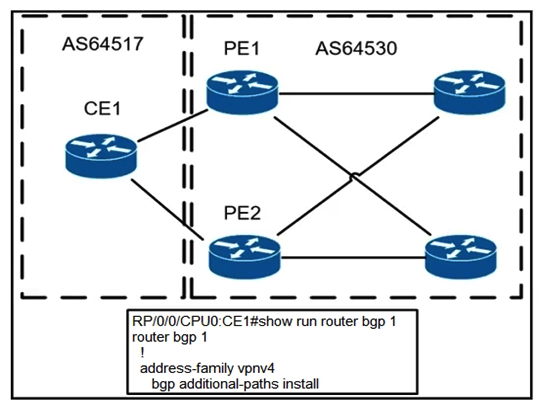 Refer to the exhibit. A network operator is configuring BGP PIC on CE1 on already established neighborships with PE1 and PE2 inside the fully converged MPLS network. Which element needs to be implemented to make this feature function effectively?
Refer to the exhibit. A network operator is configuring BGP PIC on CE1 on already established neighborships with PE1 and PE2 inside the fully converged MPLS network. Which element needs to be implemented to make this feature function effectively?A) Bidirectional Forwarding Detection must be applied to the upstream facing BGP interfaces
B) The operator must ensure that all prefixes have the same next-hop from PE1 and PE2 for BGP PIC
C) A reserved BGP community of 1:10 must be used to denote the PIC feature set to the routing protocol
D) BGP import/export policies must be applied on all devices for the routes needing BGP for PIC

Unlock Deck
Unlock for access to all 74 flashcards in this deck.
Unlock Deck
k this deck
74
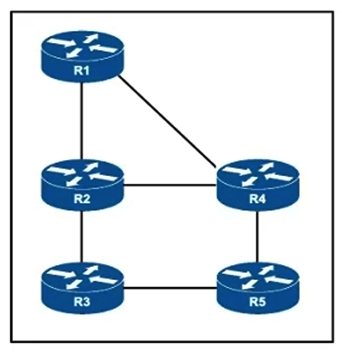 Refer to the exhibit. An engineer has configured all routers in the environment to run IS-IS Level 1 and Level 2 routing. The engineer wants traffic from R1 to R5 to pass via R2, but IS-IS routing has calculated the best path via R4. Which action corrects the problem?
Refer to the exhibit. An engineer has configured all routers in the environment to run IS-IS Level 1 and Level 2 routing. The engineer wants traffic from R1 to R5 to pass via R2, but IS-IS routing has calculated the best path via R4. Which action corrects the problem?A) Set the link metric on R2 for the links from router R2 to routers R3 and R4 to 30 or more
B) Set the link metric for the link from router R1 to router R4 to 30 or more
C) Configure routers R1, R4, and R5 for Level 2 routing only
D) Configure routers R1, R2, and R5 for Level 1 routing only

Unlock Deck
Unlock for access to all 74 flashcards in this deck.
Unlock Deck
k this deck



